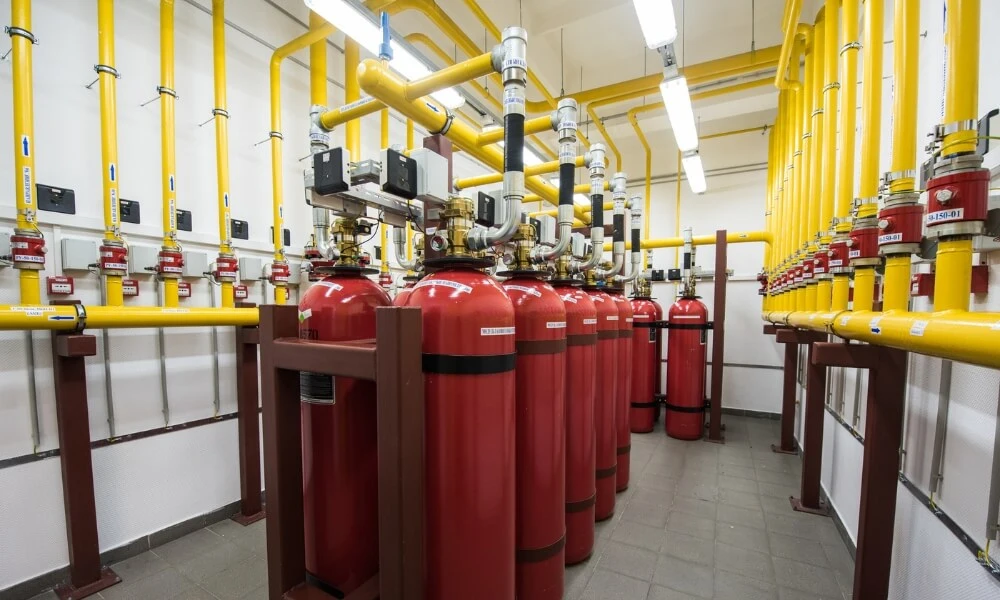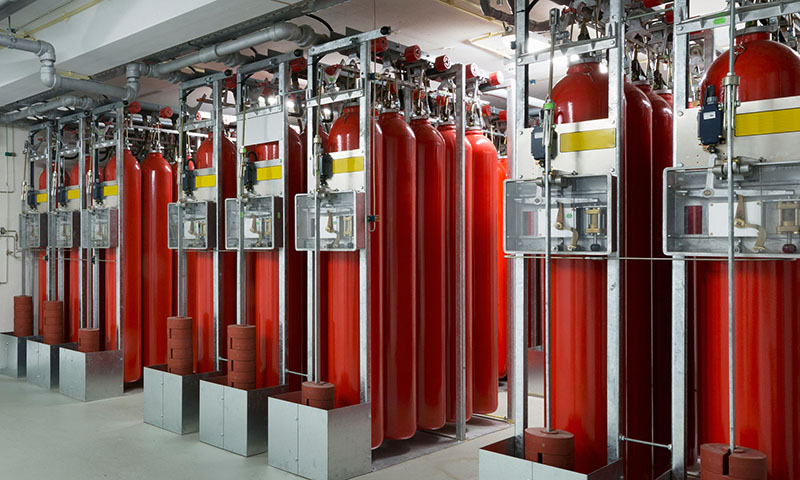Fire suppression systems in domestic homes have become increasingly important for protecting lives and property, with companies such as QSD Fire offering options ranging from traditional sprinklers to innovative water mist technology. These systems are designed to detect and extinguish fires quickly, providing crucial time for occupants to evacuate safely and minimizing damage to the home.
Water Mist Suppression Systems
Water mist suppression systems represent a cutting-edge approach to fire protection in domestic settings, offering numerous advantages over traditional sprinkler systems. These innovative systems work by dispersing ultra-fine water droplets that effectively combat fires through a combination of cooling, oxygen displacement, and radiant heat blocking.
The key to water mist systems’ effectiveness lies in the size of the water droplets they produce. By forcing water through specially designed micro nozzles, these systems create a mist with droplets typically smaller than 1000 microns. This fine mist provides a significantly larger surface area for heat absorption compared to conventional sprinklers, allowing for more efficient fire suppression.
Water mist systems offer several notable benefits for home fire protection:
- Water efficiency: They use up to 80% less water than traditional sprinkler systems, reducing potential water damage to property.
- Rapid fire control: The mist quickly absorbs heat and displaces oxygen, suppressing fires at an early stage of development.
- Minimal collateral damage: Due to the use of less water, these systems cause less damage to electronics, furniture, and other valuable items in the home.
- Versatility: Water mist is effective against a wide range of fire types, including Class A (solid materials), B (flammable liquids), and C (electrical equipment) fires.
- Environmental friendliness: The systems use only water, without any additives, making them safe for occupants and environmentally friendly.
Installation of water mist systems in homes is becoming increasingly popular due to their discreet nature and adaptability to various architectural designs. The systems can be seamlessly integrated into both new constructions and existing buildings, offering a modern alternative to traditional fire sprinklers.
As fire safety technology continues to evolve, water mist suppression systems are emerging as a highly effective, efficient, and environmentally conscious choice for protecting homes and their occupants from the devastating effects of fires.
Wireless Fire Alarm Integration
Wireless fire alarm integration represents a significant advancement in home safety technology, offering a seamless blend of traditional fire detection with modern smart home capabilities. These systems utilize radio frequency communication to connect various components, eliminating the need for extensive wiring and providing greater flexibility in installation and placement.
One of the primary advantages of wireless fire alarm systems is their quick and non-invasive installation process. Unlike conventional wired systems, wireless alarms can be set up without disrupting the building’s structure or aesthetics, making them ideal for both new constructions and retrofitting existing homes. This ease of installation translates to reduced labor costs and minimal disruption to daily activities.
Wireless fire alarms are designed to be as reliable as their wired counterparts, adhering to British and European standards for fire safety. Advanced encryption technologies ensure secure communication between devices, mitigating concerns about potential interference or hacking. These systems often incorporate redundancy measures, such as multiple communication paths, to enhance overall reliability.
Integration with smart home ecosystems is a key feature of modern wireless fire alarm systems. When smoke is detected, these alarms can trigger a series of automated responses:
- Illuminating smart lamps to light escape routes
- Opening smart shutters for improved ventilation and visibility
- Sending real-time alerts to homeowners’ smartphones
This level of integration allows for a more comprehensive and responsive fire safety strategy, potentially reducing response times and improving outcomes in emergency situations.
Wireless fire alarm systems also offer enhanced flexibility and scalability. Devices can be easily added, removed, or relocated as needed, allowing the system to adapt to changing home layouts or temporary setups. This adaptability is particularly beneficial for rental properties or spaces that undergo frequent reconfigurations.
Cost-effectiveness is another significant advantage of wireless systems. While initial costs may be comparable to or slightly higher than traditional wired systems, the reduced installation time and easier maintenance can lead to long-term savings. Additionally, the portability of wireless devices means they can be reused in different locations, further enhancing their value proposition.
For homeowners looking to integrate fire safety with their existing smart home setups, hybrid systems offer an attractive solution. These systems combine hardwired and wireless technologies under a single control regime, allowing for a tailored approach that maximizes the benefits of both technologies.
As wireless fire alarm technology continues to evolve, we can expect to see even greater integration with other smart home systems, improved battery life, and enhanced detection capabilities. These advancements will further solidify the role of wireless fire alarms in creating safer, more responsive home environments.
Comparing Water Mist and Sprinklers
Water mist and traditional sprinkler systems are both effective fire suppression methods for homes, but they differ in several key aspects. Here’s a comparison of these two systems:
- Water usage: Water mist systems use significantly less water, typically 80-90% less than traditional sprinklers. This results in reduced water damage to property and belongings.
- Droplet size: Sprinklers produce larger water droplets, while water mist systems create a fine mist with much smaller droplets. This difference affects how each system interacts with fire.
- Fire suppression mechanism:
- Water mist systemswork in three ways:
- Cooling the fire and surrounding area
- Displacing oxygen through evaporation
- Blocking radiant heat
- Traditional sprinklersprimarily suppress fires by drenching the area.
- Water mist systemswork in three ways:
- Activation speed: Water mist systems typically have faster activation times compared to conventional sprinklers with frangible bulbs.
- Coverage area: Traditional sprinklers are generally better suited for covering large areas, such as warehouses or industrial spaces.
- Installation:
- Water mist systems can be easier to install, especially in properties with low water flow.
- Traditional sprinklers often require high pressures and large flow rates or a dedicated water tank.
- Property damage: Due to using less water, mist systems typically cause less damage to property and sensitive equipment.
- Versatility: Water mist systems are more versatile and can be used in areas where traditional sprinklers might not be suitable, such as near sensitive electronic equipment or in heritage sites.
- Cost: On average, traditional sprinkler systems tend to be less expensive to install, especially for larger areas.
- Maintenance: Traditional sprinklers generally require less frequent maintenance due to having fewer components exposed to the elements and a lower risk of clogging.
- Effectiveness against different fire types: Water mist systems are effective against a wider range of fire types, including Class A (solid materials), B (flammable liquids), and C (electrical equipment) fires.
When choosing between these systems, consider factors such as the specific fire risks in your home, water availability, potential for water damage, and the presence of sensitive equipment or valuable items that could be affected by water exposure.
Fire Blanket Essentials
Fire blankets are essential fire safety devices designed to extinguish small fires quickly and effectively. Made from fire-resistant materials such as fiberglass or woven-nylon coated with silicone-based flame retardants, these blankets work by smothering fires and cutting off their oxygen supply.
Fire blankets are particularly effective for combating Class F fires involving cooking oils and fats, as well as small fires in waste bins or on clothing. They are commonly used in kitchens, both domestic and commercial, but are also suitable for various other settings such as workshops, caravans, and boats.
The key advantages of fire blankets include:
- Quick and easy deployment: Fire blankets require no special training to use, making them accessible to everyone.
- Safety: Unlike some fire extinguishers, fire blankets don’t use pressure, temperature changes, or electricity, minimizing the risk of injury during use.
- Versatility: They can be used on various types of small fires, including those involving flammable liquids and electrical equipment.
- Environmental friendliness: Fire blankets don’t contain harmful chemicals, reducing their environmental impact.
- Low maintenance: They don’t require annual servicing or recharging, making them cost-effective in the long run.
When selecting a fire blanket, consider the size of potential fires you might encounter. Sizes typically range from 1m x 1m for small domestic use to 1.2m x 1.8m for larger commercial applications. It’s crucial to choose a fire blanket that meets the British Standard BS EN 1869:1997, ensuring it has been tested to the appropriate safety standards.
To use a fire blanket effectively:
- Pull the tabs to release the blanket from its container.
- Hold the blanket by its edges, protecting your hands.
- Carefully place the blanket over the fire, completely covering it.
- Leave the blanket in place until the fire is extinguished and the area has cooled.
Fire blankets should be installed in easily accessible locations, approximately 1-2 meters away from potential fire sources like cookers. They should be replaced immediately after use or if damaged, and typically have a lifespan of about 7 years.
While fire blankets are highly effective for small fires, it’s important to remember that they should be used as part of a comprehensive fire safety strategy. For optimal protection, consider pairing fire blankets with appropriate fire extinguishers, such as water mist or wet chemical extinguishers for kitchen environments.
Summary
In summary, fire suppression systems play a vital role in home safety. Water mist suppression systems, wireless fire alarms, and fire blankets each provide distinct benefits and work well as part of a comprehensive fire safety strategy. Water mist systems offer efficient water usage, rapid fire control, and minimal collateral damage, making them suitable for residential applications. Wireless fire alarms integrate seamlessly with smart home ecosystems, providing flexible, scalable, and reliable fire detection. Fire blankets are ideal for small fires and are easy to use, requiring minimal maintenance and reducing environmental impact.
Together, these fire safety tools offer a robust approach to protecting homes and their occupants, with each system tailored to address different types of fire risks and property requirements.





